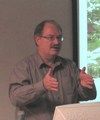ENGINEERED NATURE: “The world is round, but Detroit is extremely flat,” said Palencia Mobley, chief engineer, when explaining the approach to Green Stormwater Infrastructure

In Detroit, simply making a park where there was once a building is often not enough to prevent flooding due to its topography and geology: “We don’t have a lot of elevation to move water. Another problem is that Detroit is full of clay soil which doesn’t readily absorb water,” said Palencia Mobley. So many Green Stormwater Infrastructure projects in Detroit excavate the clay and mix it with sand or gravel so water can move underground faster.










